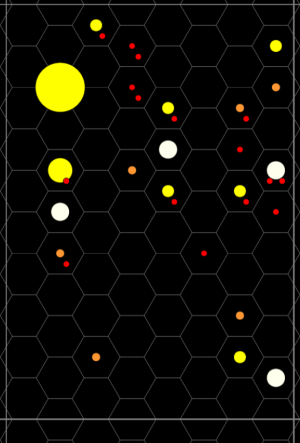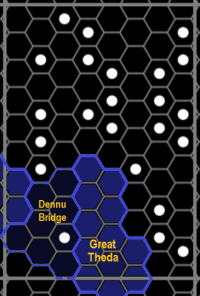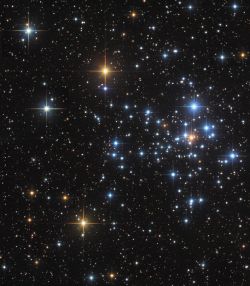Warzone (Iphigenaia) Subsector
| Warzone (Iphigenaia) Subsector | ||||||
|---|---|---|---|---|---|---|
| ||||||
| Sector | Iphigenaia | |||||
| Capital | None | |||||
| No. of Stars | 23 | |||||
| Majority Control | Non-Aligned (NaXX) - 100% | |||||
Warzone Subsector is Subsector G of Iphigenaia Sector.
- It lies within Charted Space.
- The name is officially Efusa Rift Subsector, but that is now rarely used.
Description (Specifications)[edit]
Warzone Subsector was a backwater with a few scattered human settlements until less than a century ago.
- The older name dates from the earliest period of Muirimi settlement.
- There is ongoing conflict between Aslan and human interests within the region: vessels from both human and Aslan polities conduct aggressive patrols.
- Aslan Ihatei attempted to occupy the area, moving in from trailing. Humans from the Regency of Muirimi resisted them.
- All outposts and settlements in the subsector have suffered destructive raids: many worlds have abandoned ruins located on them.
- The resources of the subsector are untapped.
Astrographic Features & Trade Routes: 1105[edit]
The following astrographic and commercial data has been determined regarding Warzone Subsector:
- The subsector is a lower stellar density region.
- The brightest star is the yellow giant primary of the Karvak system.
- No trade routes are noted as crossing the region.
Stellar Distribution[edit]
A basic map showing the distribution and size of stars within Warzone Subsector.
- The color corresponds to the visible color of the star, which links to its spectral classification.
- The size as shown indicates both the physical size of the object and its relative brightness.

(Chart sourced from Traveller Map).
Note that the stars as depicted are representative. Any star, no matter what its size, is a mere speck within the hex it occupies.
- Ordinary main sequence stars can barely be seen from even a hex away.
- Huge, intensely luminous giant stars can be seen from across the subsector and far beyond.
Rift Regions[edit]
Two rift areas lie within the subsector: the Theda-Spin and the Great Theda.
- The Theda-Spin occupies the spinward part of the subsector.
- The Great Theda occupies the central and rimward parts of the subsector.
- A single link across the void is located at the Dennu system: this is known as the Dennu Bridge.
- All three regions are considered to form a larger void known as the Efusa Rift.
The subsector lies close to the edge of the Great Rift: the Efusa Rift is considered to be an isolated element of the Great Rift.
A simple map showing rift regions within Warzone Subsector.

(Chart sourced from Traveller Map)
Locally at least, a rift is an astrographic concept based on Jump Drive performance.
The highest tech level commonly encountered out this Far Along (spinward of the Third Imperium) is TL–12, though a few worlds may be more advanced.
- This level of technology allows the routine use of up to Jump-3 drives.
- Areas that cannot be crossed by Jump-3-capable vessels are denoted as rifts.
Borealis Group[edit]
The Borealis Group can be seen as a bright, dense, noticeable grouping of stars in the skies to Spinward.
- It is a huge cluster of stars centered on the supergiant Theta Borealis.
- It is a distinctive astrographic feature that can be observed from all across Charted Space.
World Listing[edit]
Comprehensive Second Survey data for all worlds lying within Warzone Subsector is available.
- The primary source material for all data is Traveller Map.
- Other sources may differ: some elements of the data may be contradictory or incorrect.
- Data is occasionally updated as new information becomes available.
- Scouting missions gathering reliable, verified data can receive substantial payment.
AAB library archives contain expanded data about the following systems:
Note that some Second Survey data, though only 40 years old, may already be out of date.
- Verified updated data is constantly sought.
History & Background (Dossier)[edit]
Warzone Subsector was always a wilderness, dominated by the impassable fastnesses of the Efusa Rift, and that was the way the isolationist Muirimi peoples liked it.
Human settlement began when the Aslan began to enter the sector in numbers. The newly founded Regency of Muirimi sought to establish a buffer zone between the invaders and its territory and soon military clashes occurred. Decades of skirmishing and conflict between the two powers have reduced the region to an empty wasteland, with worlds littered with wreckage and dotted with ruins.
Polity Listing[edit]
No polities exist within this subsector.
Native Sophonts (NILs)[edit]
No races (sophont species) are believed to have originated within this subsector.
Demographics[edit]
The subsector is officially uninhabited. Military patrols or scavengers may occasionally be found within its borders.
Major Historical Events Timeline[edit]
- ca -1900: The first known human explorers are active in the region (a few Terrans of the Rule of Man). They may well have crossed the subsector.
- -1776: The Long Night begins.
- Year 0: Far to trailing, across the Great Rift, the Third Imperium is founded.
- 100s-200s: A few pioneering Imperial explorers pass through the region.
- 300-420: The First Survey charts the subsector.
- 995-1065: The Second Survey charts the subsector.
- ca 1000: Aslan scouts and pioneers begin to appear in the sector.
- 1050s: The newly established Regency of Muirimi begins establishing outposts in the region.
- 1060s: The Aslan establish settlements within the sector.
- 1065: The Second Survey is published.
- 1070s-present: Ongoing military clashes between the Aslan and the Regency.
Subsector Summary[edit]
Note that this section is awaiting an AAB Internal Records update.
Warzone, subsector G of Iphigenaia contains 23 worlds with an estimated population of less than 1 million, a per capita income of Cr0, and a total economy is BCr0. These worlds originate an interstellar trade of BCr2 through 0 starports (0 Class A, 0 Class B, 0 Class C, 0 Class D) employing 630 people. Driving this interstellar trade are no Agricultural (Ag) worlds, no Non-Agricultural (Na) worlds, no Pre-Agricultural (Pa) worlds, no Pre-Industrial (Pi) worlds, no Rich (Ri) worlds, and no Industrial (In) worlds. The average technology level is 1 (with most between 0 and 3). The highest technology level is 5 at [[(world)|]] (Iphigenaia 1814) and [[(world)|]] (Iphigenaia 2319).
Warzone, subsector G of Iphigenaia contains 35 stars and no identified planets; 13 monostellar systems, nine binary systems, no trinary systems, and one system with four or more stars. 18 of the 23 systems (78%) have native gas giants. There are no Asteroid (As) belts, three Desert (De) worlds, no Garden (Ga) worlds, one Ice-capped (Ic) world, four Poor (Po) worlds, four Vacuum (Va) worlds, and two Water (Wa) or Ocean (Oc) worlds.
Warzone has no inhabitants.
| 1 identified sophont populations in Warzone | |
|---|---|
|
References & Contributors (Sources)[edit]
- Mark Gelinas. Dark River (Tidewater Traveller Club, 1988), .
- Peter G. Celella, James Holden. Solomani & Aslan (Digest Group Publications, 1991), 50, 51. (dot map provided)
- Author & Contributor: Jo Grant of CORE (generated data)
- Author & Contributor: Lord (Marquis) and Master Scout Emeritus Adie Alegoric Stewart of the IISS
